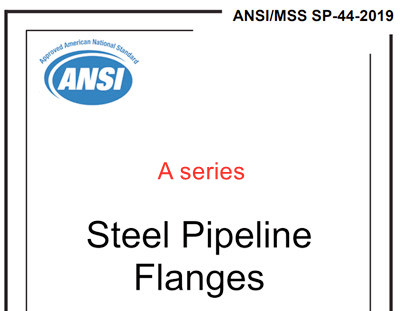Choose A or B series for large-diameter flanges
1. A series or B series
When selecting American standard flanges, if the large diameter is greater than DN600, it is necessary to consider using a large diameter flange.
The selection of national standards generally follows the standard HG/T 20623-2009
.
ASME is selected according to ASME B16.47-2020.
It is common for designers to choose a large-diameter flange model without specifying whether the flange should be labeled as A series or B series, resulting in the purchase of the wrong flange and causing huge economic losses.
Forgings are expensive, while large forgings are even more expensive.
So why do large-diameter flanges need to be divided into A series or B series, and why not unify them?
From the preface of the specification, we can understand that:
The American National Standards (ANSI) B16 Committee developed flanges ranging from 26 “to 60” in December 1982, with flange dimensions based on the manufacturer’s standardization association’s standard practice MSS SP 44 Steel Pipe flanges.
The subsequent B16.47 update includes flange dimensions for API 605 Large Diameter Carbon Steel flanges.
Used for Class150 and 300, as well as NPS36 or smaller sizes, API 605 and MSS SP-44 flanges are not compatible and cannot be paired at all.
For ease of differentiation, MSS SP-44 flanges are designated as A-series. API 605 flanges are designated as B-series.
2. Differences between A series and B series

What is the difference between the A series and the B series?
Generally speaking, under the same size and pressure rating, ASME B16.47 A series flanges are thicker, heavier, and stronger than B series flanges.
So, from a business perspective, A-series flanges are generally more expensive than B-series flanges.
From the figure below, with the same pressure rating and nominal diameter, it can be intuitively felt that the A series is more majestic and enthusiastic. In contrast, the B series is more exquisite and compact.
B-series flanges require more but smaller fasteners (bolts and nuts) than A-series flanges, and the center circle diameter of the bolts is smaller than A-series flanges.
Both the A series and B series defineraised face (RF) butt welding flanges and flange covers, but only the A series has ring connection face (RJ) flanges ranging from Class300 to Class900.
The size of the connecting pipe provided by the A series is completely different from that of the connecting pipe provided by the B series. The outer diameter of the A series nozzle for DN650 Class150 is 660.4, and the B series nozzle is 661.9.
It is worth noting that the outer diameter of the flange welding end (connecting pipe outer diameter) of the A series is independent of the pressure level. In contrast, the outer diameter of the flange welding end of the B series varies among different pressure levels.
For example, for the B series flange of DN800, the outer diameter of Class150 is 814.3, the outer diameter of Class300 is 819.2, and the outer diameter of Class600/900 is 812.8.
For DN1500, the connecting pipe of Class150 is 1527, and the outer diameter of the connecting pipe of Class300 is 1557.3, with a difference of 30mm. I have encountered a friend who used to check the standard for errors but made a mistake in the outer diameter of this DN, resulting in the scrapping of the paired connection.
How do you choose the large-diameter flange series?
Generally, the owner will provide flange requirements for A series or B series according to the owner or contract agreement.
Due to the large redundancy of the A-series, uniform pipeline size, and the addition of an RJ sealing surface, most pipeline users or designers may choose A-series flanges for new pipelines or equipment.
In general, the B series is affordable and compact in structure, or previous devices that used API 605 need to be refurbished or replaced, or the equipment itself has flanges or maintenance holes. Using the B series can save construction costs.
Of course, the B series may sometimes be cheaper than the A series; for example, for Class300 and larger than DN950, the B series flange is heavier than the A series.
Of course, not all high-pressure levels are heavier than low-pressure levels. For example, the A series DN950 weighs 326.9kg for Class150 and 315.6kg for Class300.
Of course, not all large-diameter ones are heavier than small-diameter ones; for example, the DN900 of the A-series Class300 is 578.9kg, and the DN950 is 315.6kg. The weight of DN650 for Class150 and B series is 54.5kg, and the weight of the WN flange for DN600 is 121.7kg.
if any question and inquiry please e-mail:info@jiade-group.com
